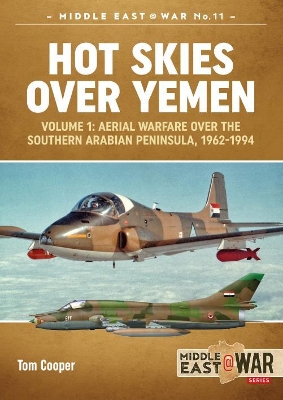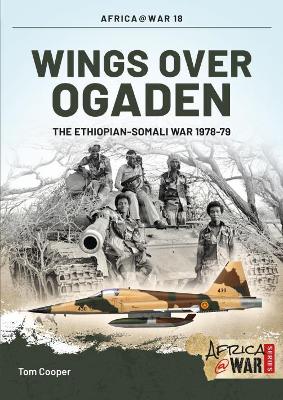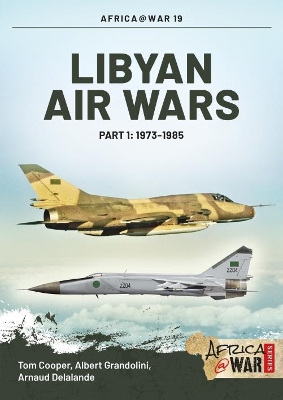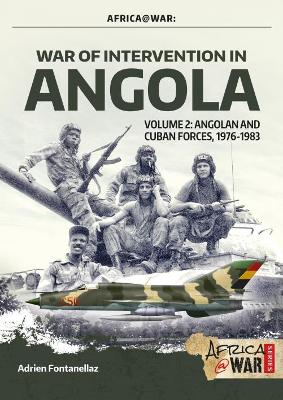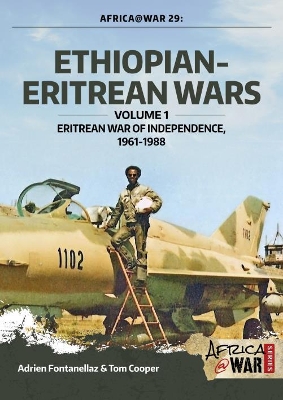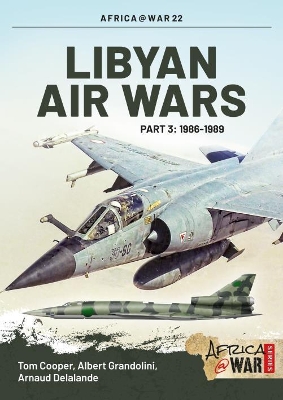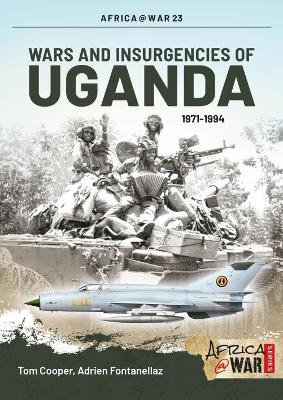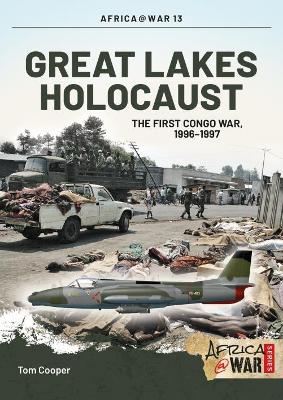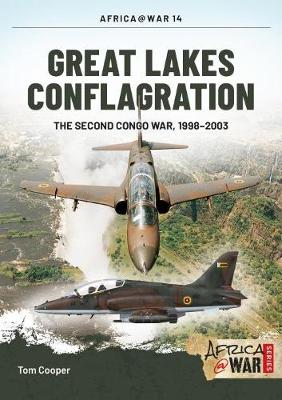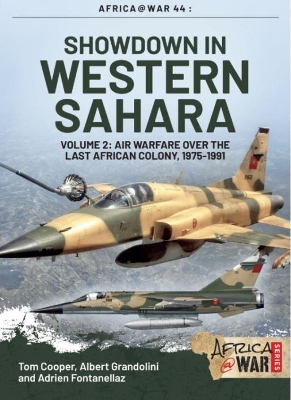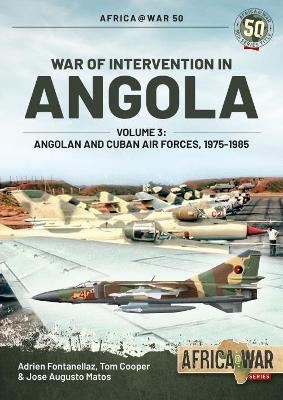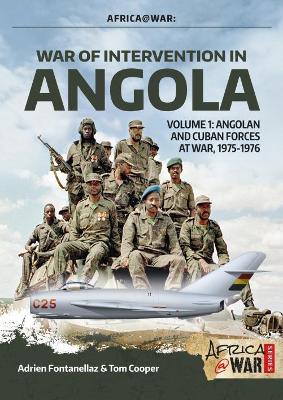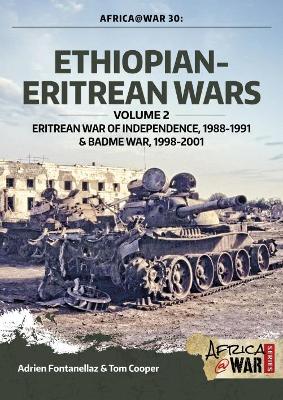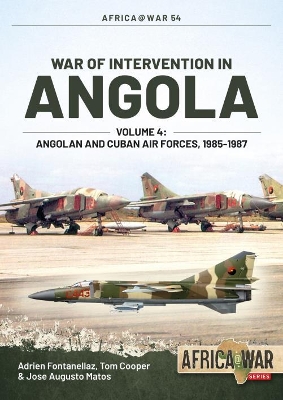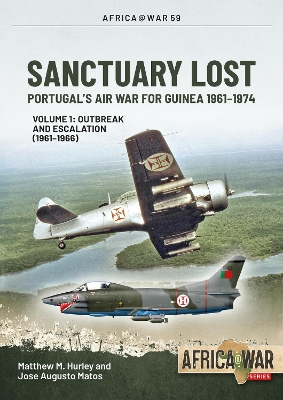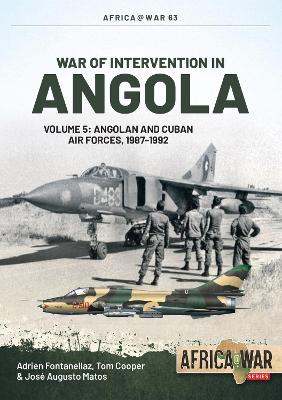Africa@War
20 total works
While at least some details about British aerial operations in what was Southern Arabia of the 1960s were published over the years, next to nothing is known about activities of other, `local' air forces - like those of Egypt - and even less so about that of Yemen. This is even more surprising considering that for nearly two decades there were no less than two, fully developed services of that kind - one operated by what was then North Yemen, another by what used to be South Yemen - and that these were deeply involved in the Cold War, too.
Using newly released secret intelligence sources, neglected memoirs, and popular memory, this book is telling the story of military flying in Yemen between 1962 and 1994. It is providing in-depth insights and analysis of campaigns fought by the Egyptian air force of the 1960s, the creation of two Yemeni air forces in the 1970s, an entire series of inter-Yemeni wars of the 1980s and 1990s.
Containing over 140 photographs, colour profiles, maps and extensive tables, Hot Skies over Yemen is a richly illustrated and unique point of reference about one segment of modern aerial warfare that remains entirely unknown until today.
This air victory practically sealed the fate of the Somali juggernaut in Ogaden, especially so once Ethiopia convinced Cuba and the Soviet Bloc to support her instead of Somalia. In a fit of pique, Somalia forced all Soviet advisers to leave the country. Already bitter over similar experiences in Egypt in 1972, Moscow's revenge was designed as a clear message: nobody was to treat her in such fashion again. The USSR subsequently launched an air bridge to Ethiopia, unique and unprecedented in its extension and importance, delivering huge quantities of armament and equipment necessary for the Ethiopians to reconquer Ogaden, and beyond. In turn Somalia asked the USA for help and thus occurred an unprecedented switch of Cold War alliances.
This volume details the history and training of both Ethiopian and Somali air forces, their equipment and training, tactics used and kills claimed, against the backdrop of the flow of the Ogaden war. It explains in detail, supported by over 100 contemporary and exclusive photographs, maps and colour profiles, how the Ethiopian Air Force won the decisive victory in the air by expertly deploying the F-5Es - unequalled in manoeuvrability, small size and powerful armament - to practically destroy the Somali Air Force and its MiG-17s and MiG-21s.
Because of the Cold War but also due to confrontation with Libya over a number of other issues, France - a one-time major arms supplier to Libya - and the USA gradually got dragged into the war. Deployments of their troops and intelligence services in Chad, Egypt and the Sudan never resulted in a full-scale war against Libya, but time and again culminated in small-scale aerial operations that proved crucial to developments on the ground, several of which are still a matter of extensive debate.
Detailing not only the aerial operations but the ground war and the geo-political background of these conflicts, and illustrated with over 100 contemporary photographs, maps and all-new colour profiles, this volume provides a unique insight into an otherwise completely forgotten conflict that raged from the skies over the southern Mediterranean to southern Chad and northern Sudan, yet one that not only represented a formative period of the LAAF, but which also prompted a number of crucial modifications and developments in France and the USA.
War of Intervention in Angola, Volume 2
by Adrien Fontanellaz and Tom Cooper
Nevertheless, the war went on. The MPLA's government failed to decisively defeat UNITA, in southern Angola, and then found itself facing a coup attempt from within in May 1977. Crushed in blood, this resulted in thousands being jailed and tortured: many more escaped abroad, where they reinforced the ranks of the battered opposition.
The coup prompted the Soviets to attempt increasing their influence with the aim of establishing permanent military bases in the country. While all such overtures were turned down, Angolan operations along the border to what was then the South-West Africa (subsequently Namibia) in October 1980, combined with the increased activity of SWAPO - an insurgency against the South African control of that territory - subsequently Namibia - prompted South Africa to launch another military intervention and resume supporting UNITA. In turn, this prompted not only the Cubans to further increase their military presence, but also the Soviet Union into delivering massive amounts of military aid to the government in Luanda. Angola not only assumed the role of one of the major hot battlefields in the Cold War: its 'civil war' saw a number of major showdowns between diverse belligerents, culminating in the Battle of Cangamba in 1983.
Based on extensive research, with help of Angolan and Cuban sources, the 'War of Intervention in Angola, Volume 2', traces the military build-up of the Cuban and Soviet-supported Angolan military, the FAPLA and its combat operations, and those of the Cuban military in Angola, in the period 1976-1983, their capabilities and intentions, and their battlefield performances.
The volume is illustrated with over 100 rare photographs, half a dozen maps and 18 colour profiles.
Through mid and late 1985, relations between France and Libya became tense over the situation in Chad. By early 1986, the French felt forced to deploy their air force for an airstrike on the crucial Libyan air base at Wadi Doum, in the north of that country. Tripoli reacted with a high-profile aerial attack on N'Djamena IAP and by bolstering support for its proxies. This eventually provoked Paris to launch its third military intervention in that country, OperationEpervier.
Meanwhile, a series of terror attacks on US citizens and interests in Europe and the Mediterranean area took place. While most of these saw the involvement of Iran and Syria too, Libya was recognized as major supporter of the activities in question. In the aftermath of several traumatic experiences, the US administration began planning for direct action against the government in Tripoli and various terrorist organizations supported by it. As the Pentagon planners prepared a contingency list of targets in Libya, and the US Air Force began planning its involvement, ships and aircraft of the US Navy launched intensive operations off the Libyan coast with the aim of provoking an incident that could be used as a reason for major military attack on Libya. Eventually, these operations culminated in Operation Prairie Fire- a series of short but sharp clashes between the US Navy and Libyan air defences and the Navy, in March 1986.
Part 2 of this mini-series provides an unprecedentedly detailed and richly illustrated description of the involved air forces, their equipment and markings, and related military aerial operations, many of which have remained unknown until today, while others have been forgotten outright.
The Rwandan Patriotic Front 1990-1994
by Tom Cooper and Adrien Fontanellaz
Starting with in-depth descriptions of the history of Rwandan political, military and security development, this volume traces the history of the RPA from its emergence as a small-scale insurgent group formed from the ranks of Rwandan refugee diaspora in Uganda; its military operations and related experiences during nearly four years of war against the Rwandan government; and its establishment of control over Kigali, in July 1994. As such, the narrative presented here provides a fascinating and unique insight into the military story behind the emergence of modern-day Rwanda and its military; considered by many to be the'Israel of Africa'. Providing minute details about RPF's tactics and doctrine - that strongly influenced developments in a number of other modern-day African wars - this volume is foremost an offering that provides highly interesting backgrounds for and a prequel to, nearly all of the subsequent wars in the neighbouring Democratic Republic of the Congo.
Illustrated with over 150 photographs, colour profiles, and maps describing the equipment, colours, and markings, and tactics of the RPF and its opponents, this is a unique study about the emergence of one of the most important US allies on the African continent.
Simultaneously, the USA and France bolstered the military of the Chadian government, enabling it to subsequently launch an all-out advance against Libyan troops and proxy forces in the north of Libya. This culminated in the series of spectacular campaigns better known as 'Toyota Wars', characterised by high speed of operations and surprise. The Chadian Army defeated its opponents in 1987 and nearly launched an invasion of Libya in 1988, successfully concluding this conflict.
This title closes the Libyan Air Wars mini-series with a detailed insight into the final US-Libyan confrontation, which took place in early 1989, and culminated in another high-profile air combat between the most modern jet fighters of the Libyan Arab Air Force, and the US Navy.
As usual, the volume is richly illustrated by well over 150 contemporary and exclusive photographs, colour profiles, and maps, detailing the history, training, equipment, markings and tactics of the involved air forces.
Wars and Insurgencies of Uganda 1971-1994
by Tom Cooper and Adrien Fontanellaz
With Tanzanian leader Julius Nyerere offering sanctuary to Uganda's ousted president, Milton Obote, Ugandan relations with Tanzania soon became strained too. Already in 1972, a group of Tanzania-based exiles attempted, unsuccessfully, to invade Uganda and remove Amin. By late 1978, following another attempted coup against him, Amin deployed his troops against the mutineers, some of whom fled across the Tanzanian border. The rebellion against him thus spilled over into Tanzania, against whom Uganda then declared a state of war.
Opening with an overview of the ascent of crucial military and political figures, and the build-up of the Tanzanian and Ugandan militaries during the 1960s and 1970s, this volume provides an in-depth study of the related political and military events, but foremost of military operations during the Kagera War- also known as 'A Just War' - fought between Tanzania and Uganda in 1978-1979. It further traces the almost continuous armed conflict in Uganda of 1981-1994, which became renowned for emergence of several insurgent movements notorious for incredible violence against civilian population, some of which remain active in central Africa to this day.
This book is illustrated with an extensive selection of photographs, colour profiles, and maps, describing the equipment, markings, and tactics of the involved military forces.
The narrative traces the ascent of crucial Rwandan, Congolese and Ugandan military and political figures, and their connections within influential business and political circles in and outside Africa. It examines the build-up of the Zairian military under the government of dictator Mobutu Sese Seko in the 1960s and 1970s, and provides an in-depth study into reasons for its near-collapse in the early 1990s.
The military build-up of Rwanda and Uganda is discussed in detail as is their planning for operations inside Zaire, and the global logistic tail that provided the Rwandan military, particularly, but also most of its opponents, with a capability of not only waging war beyond their borders, but - in the case of Rwanda - of invading and practically conquering a country the size of Western Europe or the USA east of the Mississippi.
The book further traces the covert Rwandan military actions inside Zaire, initially run under the guise of an insurgency by one of Zaire's ethnic minorities; how ever-deepening Rwandan operations inside Zaire were practically dictated by concentrations of Hutu refugees; and how the insurgency - led by Laurent-DesireKabila who was installed by key Rwandan and Ugandan military and political figures - developed into an organisation that sought autonomy from the military and political dictates of Rwanda, in turn delivering a direct reason for the Second Congo War which was fought from 1998-2003.
Recounted is the Rwandan attempt to topple the government of Laurent Kabila through an operation that saw a redeployment of some of best Rwandan units from Kigali and Goma to the western DRC, resulting in a series of fierce air-land clashes with Zimbabwean and Angolan forces and culminating in the Battle of Kinshasa. Also described is the fighting along what became the 'Eastern Front' in the DRC, as Zimbabwean and allied troops attempted to stop Rwandan, Ugandan and rebel advances out of Kivu Province in the direction of the Congo River through 1998 and 1999.
These early phases of the war, or 'The First African War' as it has come to be known, were characterised by surprising outflanking and infiltration manoeuvres; foreign mercenaries; Zimbabwean Hawk and Lynx light strikers flying intensive combat operations from N'Djili airport, half of which was occupied by Rwandans, Ugandans and Congolese rebels; interdiction strikes guided by special forces deployed deep behind enemy lines; operations of helicopter gunships and transport aircraft under intense ground attack in support of troops cut off by advancing opponents; use of transport aircraft as makeshift bombers in bad weather and by night and clashes of armoured forces and many other elements of 'high-technology' warfare.
All the protagonists deployed their best military units, their best equipment and some of their best military commanders, yet despite their best efforts, and hampered by infighting, the conflict ultimately resulted in a stalemate which dragged on for a further three years while negotiations bogged down.
This book is illustrated with an extensive selection of exclusive photography, colour profiles and markings, making it of special interest to enthusiasts and professionals alike.
Showdown in the Western Sahara Volume 2
by Tom Cooper, Albert Grandolini, and Adrien Fontanellaz
Following the Spanish withdrawal from Spanish Sahara in 1975, a major war erupted as Sahrawi nationalists - organized by the POLISARIO front - engaged in guerrilla warfare against Moroccan armed forces deployed to secure the northern part of the country, and Mauritanian forces deployed in the south.
Characteristically for this period, POLISARIO's insurgency was often misinterpreted in the West as 'Soviet-influenced', although the rebels never adapted any related frameworks for their operations and tactics, such as those of Mao Zedong. On the contrary, while Algeria at least tolerated their bases on its soil, it was Libya that provided most of the support for the insurgency, eventually enabling it to defeat the Mauritanian military, slightly over a year later. Combined with POLISARIO's raids deep into Mauritania this prompted France to launch a limited military intervention in support. While tactically successful, this proved insufficient: Mauritania withdrew in 1979 after signing a peace treaty.
Morocco continued fighting a series of bitter campaigns through 1979 and 1980, until rising costs and casualties prompted its government into developing an entirely new strategy. Construction of extensive earthen fortifications eventually slowed the war down to one of low intensity, only sporadically interrupted by insurgent attempts to achieve at least local successes. With both sides realizing that no solution through an armed conflict was possible, a cease-fire agreement was signed in 1991. However, this conflict still remains unresolved: it merely shifted to civilian resistance.
Warfare in Western Sahara has in many ways become exemplary for modern-day counter-insurgency efforts in Africa and elsewhere. This conflict has been falsely declared as a part of some larger, external conflict - the Cold War; in regards of the concept of an insurgency applying motorized forces to deliver often spectacular 'hit-and-run' attacks; and in regards of a conventional military reacting with a combination of earth berms and air power.
Illustrated by over 100 photograph as, a dozen maps and 18 colour profiles, Showdown in Western Sahara offers a fascinating study of the military aspects of this conflict, warfare strategies, tactics and experiences with different weapons systems.
War of Intervention in Angola, Volume 3
by Adrien Fontanellaz, Jose Matos, and Tom Cooper
Most accounts of this conflict - better known in the West as the 'Border War' or the 'Bush War', as named by its South African participants - tend to find the operations by the FAPA/DAA barely worth mentioning. A handful of published histories mention two of its MiG-21s claimed as shot down by Dassault Mirage F.1 interceptors of the South African Air Force (SAAF) in 1981 and 1982, and at least something about the activities of its MiG-23 interceptors during the battles of the 1987-1988 period.
On the contrary, the story told by Angolan and Cuban sources not only reveals an entirely different image of the air war over Angola of the 1980s: indeed, it reveals to what degree this conflict was dictated by the availability - or the lack of - air power and shows that precisely this issue dictated the way that the commanders of the Cuban contingents deployed to the country - whether as advisors or as combat troops - planned and conducted their operations.
It is thus little surprising that the first contingent of Cuban troops deployed to Angola during Operation Carlota, in late 1975, included a sizeable group of pilots and ground personnel who subsequently helped build-up the FAPA/DAA from virtually nothing. They continued that work over the following 14 years - sometimes in cooperation of Soviet advisors and others from East European countries - eventually establishing an air force that by 1988 maintained what South African military intelligence and the media subsequently described as the 'most advanced air defence system in Africa'. Not only the air defence system in question, but also the aircraft serving as its extended arms, ultimately managed a unique feat in contemporary military history: they enabled an air force equipped with Soviet-made aircraft and trained along the Soviet doctrine to establish at least a semblance of aerial superiority over an air force equipped with Western-made aircraft and operating under a Western doctrine.
Based on extensive research with help of Angolan and Cuban sources, the 'War of Intervention in Angola, Volume 3', traces the military build-up of the FAPA/DAA in the period 1975-1992, its capabilities and its intentions. Moreover, it provides a unique, blow-by-blow account of its combat operations and experiences.
The volume is illustrated with 100 rare photographs, half a dozen maps and 15 colour profiles, thus providing a unique source of reference on this topic.
Affairs like the CIA's efforts to destabilise Angola for little else but to recoup its prestige after the catastrophic defeat in South Vietnam, or the South African military intervention in Angola - Operation Savannah - have attracted lots of public attention and are relatively well covered in related publications. On the contrary, the final stages of the Portuguese withdrawal, the military build-up of three native insurgent forces, and then the onset of the Cuban military intervention in Angola - Operation Carlotta run in 1975 and 1976 - remain largely unknown.
Based on extensive research with help of Angolan and Cuban sources, the War of Intervention in Angola is providing a unique insight precisely into the latter topic. It traces the failures of the US-supported FNLA, the growth and reorganization of the MPLA into a conventional army; deployment of Cuban military contingents, their capabilities and intentions; and the performance and experiences of the MPLA and Cuban forces at war with South Africans and the third Angolan insurgent group - UNITA.
The volume is illustrated with over 100 rare photographs, a dozen of maps and 15 colour profiles.
Crucial between these was the Eritrean War of Independence. Fought 1961-1991, this was one of biggest armed conflicts on the African continent, especially if measured by numbers of involved combatants. It included a wide spectrum of operations, from 'classic' counter-insurgency (COIN) to conventional warfare in mountains - with the latter being one of the most complex and most demanding undertakings possible to conduct by a military force.
Campaigns run during the Eritrean War of Independence often included large formations of relatively well-equipped forces, led by well-trained commanders, along well-thought-out plans, based on home-grown doctrine. The air power played a crucial - although not necessarily decisive - role in many of battles.
Nevertheless, most of details about this conflict remain unknown in the wider public. Similarly, relatively few Western observers are aware of relations between the Eritrean liberation movements, and various dissident and insurgent movements inside Ethiopia - although the synergy of these eventually led the downfall of the so-called Derg government, in 1991.
While the first volume in this mini-series spanned the history of wars between Ethiopia and Eritrea between 1961 and 1988, the second covers the period since. Correspondingly, it is providing coverage of military operations that led to the fall of the Derg government in Ethiopia of 1991, the period of Eritrean military build-up and a complete re-organization of the Ethiopian military in the 1990s, and concludes with the first detailed account of the so-called Badme War, fought between Ethiopia and Eritrea in period 1998-2001.
It is illustrated by many contemporary photographs, maps and colour profiles.
Narby, their common history as former French colonies resulted in a short war between Algeria and Morocco, which in turn prompted an arms race that lasted well into the 1980s.
Following much more action than was ever reported in the media, and amid growing resistance from natives and increasing international pressure, Spain withdrew from Spanish Sahara in 1975, indirectly opening a new chapter of this part of the world, which is going to be covered in Volume 2.
Warfare in Western Sahara has in many ways become exemplary for modern-day counter-insurgency efforts in Africa and elsewhere. This is so in regards of this conflict being mis-declared as a part of some larger, external conflict - like the Cold War - in regards of the concept of an insurgency applying motorized forces to deliver often spectacular 'hit-and-run' attacks; and in regards of a conventional military reacting with a combination of earth berms and air power.
Illustrated by over 100 photographs, dozen of maps and 15 colour profiles, Showdown in Western Sahara, Volume 1 offers a fascinating study of the military aspects of this conflict, warfare strategies, tactics and experiences with different weapons systems.
War of Intervention in Angola, Volume 4
by Adrien Fontanellaz, Tom Cooper, and Jose Augusto Matos
Many accounts of this conflict - better known in the West as the 'Border War' or the 'Bush War', as named by its South African participants - consider the operations of the FAPA/DAA barely worth commentary. At most, they mention a few air combats involving Mirage F.1 interceptors of the South African Air Force (SAAF) in 1987 and 1988, and perhaps a little about the activity of the FAPA/DAA's MiG-23s. However, a closer study of Angolan and Cuban sources reveals an entirely different image of the air war over Angola in the 1980s: indeed, it reveals the extent to which the flow of the entire war was dictated by the availability - or the lack - of air power. These issues strongly influenced the planning and conduct of operations by the commanders of the Angolan and Cuban forces.
Based on extensive research with the help of Angolan and Cuban sources, War of Intervention in Angola, Volume 4, traces the Angolan and Cuban application of air power between 1985-1988 - during which it came of age - and the capabilities, intentions, and the combat operations of the air forces.
The volume is illustrated with 100 rarely seen photographs, half a dozen maps and 15 colour profiles, and provides a unique source of reference on this subject.
The air war for Guinea is unique for historians and analysts for several reasons. It was the first conflict in which a non-state irregular force deployed defensive missiles against an organised air force. Moreover, the degree to which Portugal relied on its air power was such that its effective neutralisation doomed Lisbon's military strategy in the province. The FAP's unexpected combat losses initiated a cascade of effects that degraded in turn its own operational freedom and the effectiveness of the increasingly air-dependent surface forces, which felt that the war against the PAIGC was lost. The air war for Guinea thus represents a compelling illustration of the value - and vulnerabilities - of air power in a counter-insurgency context, as well as the negative impacts of overreliance on air supremacy.
